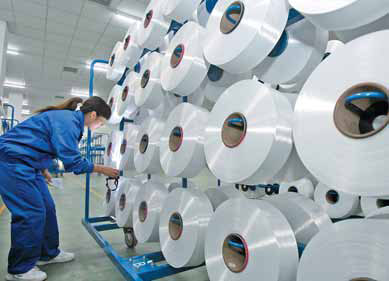Some industries still competitive
Updated: 2013-05-21 07:06
By Zheng Yangpeng (China Daily)
|
||||||||
|
A technician inspects textile materials in Nantong, Jiangsu province. China is competitive in some industries such as textiles, but it needs to take steps to sharpen its competitive edge. Xu Congjun / for China Daily |
Report highlights strengths and weaknesses of traditional sectors
The competitiveness of China's traditional industries is weakening, while its growing competitiveness in new and emerging sectors still lacks sufficient capacity, according to a report published by the Chinese Academy of Social Sciences.
Commenting on the findings, Jin Bei, director of the Institute of Industrial Economics at the CASS, which produced the report, said China's competitiveness in some low- and high-end industries remains strong, but is much less competitive in some medium-end industries, providing an unusual U-shaped curve in industrial performance.
But Jin said: "Though China performs well in some high-tech industries, that competitiveness is mainly attributed to favorable government policies."
"The core technologies are still not ours," Jin said. "China's industrialization is far from reaching the middle and late stages."
The annual report said agricultural products and high-energy consuming, high-pollution and resource-intensive industries are where the country's traditional strength has been for many years, but this is gradually weakening.
It added that the government's industrial policies do not support some of those industries any more, and that the nation's rising labor and resource costs mean it is now losing out to some countries with lower factory prices.
But while losing some advantages in traditional industries, China is gaining in other areas, most notably in electronics, machinery and chemical products, according to the report.
For the first time, the report measured the technological sophistication of China's various export markets.
It found that China's export sophistication level is now in the world's top 40 - above the world average, but still lagging well behind the United States, Germany and Japan.
Zhang Qizi, the researcher at the Institute of Industrial Economics who oversaw the writing of the report, noted that although China remains competitive in some of its traditional industries such as textiles, it still needs to strengthen such competitiveness..
"For example, China is strong in motorcycles. But if you dig deeper, you will find it holds an advantage only in low-powered motorcycles, not high-powered ones," Zhang said.
"China has also found a new strength in shipbuilding, but is still weak in building the engines that drive the ships."
To improve China's industrial competitiveness, the report suggests market forces should play a greater role.
"To adjust China's industrial structure, administrative forces and macroeconomic policies should play a limited role," said Jin.
"The traditional ways of enhancing industrial capacity, such as setting up industrial parks and giving cheap land and capital to enterprises, have produced many economic side effects, such as overcapacity," Jin said.
He said the country should rely more on building a fair, competitive environment, in which good companies could be allowed to thrive while bad companies could be allowed to fail.
zhengyangpeng@chinadaily.com.cn
(China Daily 05/21/2013 page13)

 Michelle lays roses at site along Berlin Wall
Michelle lays roses at site along Berlin Wall
 Historic space lecture in Tiangong-1 commences
Historic space lecture in Tiangong-1 commences
 'Sopranos' Star James Gandolfini dead at 51
'Sopranos' Star James Gandolfini dead at 51
 UN: Number of refugees hits 18-year high
UN: Number of refugees hits 18-year high
 Slide: Jet exercises from aircraft carrier
Slide: Jet exercises from aircraft carrier
 Talks establish fishery hotline
Talks establish fishery hotline
 Foreign buyers eye Chinese drones
Foreign buyers eye Chinese drones
 UN chief hails China's peacekeepers
UN chief hails China's peacekeepers
Most Viewed
Editor's Picks

|

|

|

|

|

|
Today's Top News
Shenzhou X astronaut gives lecture today
US told to reassess duties on Chinese paper
Chinese seek greater share of satellite market
Russia rejects Obama's nuke cut proposal
US immigration bill sees Senate breakthrough
Brazilian cities revoke fare hikes
Moody's warns on China's local govt debt
Air quality in major cities drops in May
US Weekly

|

|








